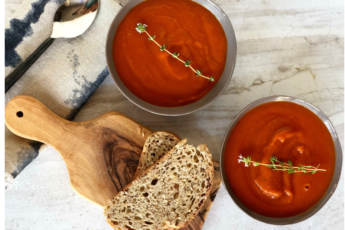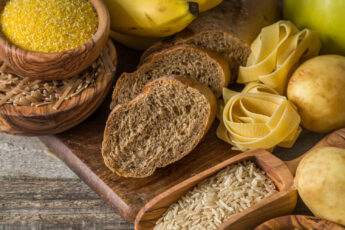The poor potato has been playing defense for years now. I speak of “white potatoes”, the poor stepchild of sweet potatoes, which have become the darling of the “starchy vegetable set” because they’re loaded with the antioxidant beta-carotene.
White Potatoes: Shots Fired
“They’re nothing but empty-calorie carbs.” “Potatoes make you gain weight.” “Diabetics shouldn’t eat them. They have a high glycemic index and shoot up your blood sugar.” “Sweet potatoes are fine. White potatoes don’t have any nutrition.”
OUCH! Anything GOOD about white potatoes?
A lot, because ALL the above are myths. Let’s tackle them one-by-one:
Myth #1: “They’re nothing but empty-calorie carbs.”
FASLSE! Potatoes are absolutely loaded with nutrition (and taste)! Just some of the nutrients in a modestly-sized baked russet potato (148 grams, or about 5.3 ounces), according to Potatogoodness.com:
- Vitamin C, 45% of the Daily Value(DV)
- Potassium: 620 mg, 18% of your DV – and, ahem, about 50% MORE than a banana!
- Fiber: % yes, the skin holds some of the fiber, but most of the other nutrients are inside.
- Vitamin B6: 10% of your DV (it’s useful for converting calories into energy the body can actually use).
#2 “Potatoes make you gain weight.”

Photo by Dan Counsell on Unsplash
Nope, but let’s clear something up: ANYTHING will cause weight gain if you eat too much of it, because the real cause of weight gain is EXCESS. Yes, excess sweets and sugar, but even excess amounts of beans, salmon, or EVOO will pack it on.
Other than for raw veggies, right-sized portions are important no matter what you’re eating, even healthy foods. And prep method counts here, too. Deep-frying ANYTHING, even raw kale, in oil of any sort, ups the calories like mad. Potato chips and French fries get most of their calories from oil, not the potatoes. People love the combo of added fat and salt, so anything deep-fried is easy to overeat. See below for delicious ways to eat your taters so you can have them more often.
#3 “Diabetics shouldn’t eat potatoes because they have a high glycemic index (GI) and shoot up your blood sugar.”
Registered dietitian-nutritionist Rosanne Rust, literally wrote a book on this. As author of The Glycemic Index Cookbook For Dummies, she boiled it down by saying, “GI is a ranking given to foods based on how quickly they increase blood sugar levels (High is considered >70, medium 55-69, and low <55). Potatoes do have a moderate glycemic index of about 55-89, depending on the variety and how it’s cooked. But this number isn’t meaningful on its own.” Just as important is how it’s eaten. Few people eat a potato by itself. Usually it’s part of a meal. When you eat a potato with protein and veggies, you blunt the rise in blood glucose.
Rust admits there are limits however. “If you’re talking potato chips, it really doesn’t matter whether they are made from sweet potatoes or white potatoes – they both should be a treat eaten in about a 1-ounce portion, as the fat from frying adds considerable calories, so chips aren’t the best way to benefit from potato nutrition.”
Myth #4: “Sweet potatoes, yes, white potatoes, no!”
Rust says, “Consumers sometimes view sweet potatoes as “healthier”, but this really isn’t true. Both white and sweet potatoes (or yams) are nutritious and bring their own benefits to the table. For example, in addition to their vitamin C and fiber, “both are good sources of antioxidants.” The sweet potato – at least the yellow kind, also has beta-carotene, another antioxidant.
And The (Credible) Science Says…

Photo: Keith Ayoob
Lower blood pressure: This review on the potato research found potatoes can be part of a diet that reduces hypertension. The participants were actually instructed to “eat a potato a day.”
- Heart health: A study on teen girls found that potatoes (including fried potatoes, white or sweet) did NOT raise cardiometabolic health risk.
- Gut health: Potatoes have fiber, a known “pre-biotic” because it helps feed the healthy organisms in the gut. Some of the undigested starch is called “resistant starch” and heads straight to the gut to join the fiber as a prebiotic. Increasing that resistant starch is easy: As cooked potatoes cool, about 4% of their starch becomes “resistant”.
Fun Spud Factoids
- There are over 4,000 different species of potatoes.
- Peruvians have cultivated potatoes for over 5,000 years!
- Potatoes are a vegetable! Yes, they count towards “getting enough veggies”.
Cut-To-The-Chase Takeaway
- Potatoes are delicious. Eat healthful amounts (one, if it’s 1/3 pound, half if it’s more than that), prepared in a healthy way: baked, roasted, steamed or boiled, but check out my “trifecta oven fries” recipe below for a fries fix! The portion shown in the mug is about right.
- Keep it real with add-ons. Swap sour cream for Greek yogurt. More protein, less fat and calories, plenty of taste, butter not even needed. A sprinkle of parmesan helps a lot here.
“Trifecta” Oven-Fries”: Delicious, Fast, Easy Clean-up:
- See the featured photo — not mine, but mine do look like this!
- Cut raw potatoes into “sticks” to look like thick-cut fries. Check the photo at the top.
- Rub with EVOO and season with a little salt and herbs of your choice. I like crushed rosemary, fresh or dried, and ground pepper, but smoked paprika is great, too.
- Roast on a foil-covered sheet pan at 425°F for about 20-25 minutes, until they’re soft but not mushy.
- Make extras! The next-day leftovers have that resistant starch and plenty of flavor!
Feature photo by Nathan Dumlao on Unsplash






